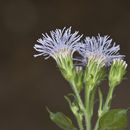tr
kırıntılardaki isimler


Tamaulipa is a genus of flowering plants in the tribe Eupatorieae within the family Asteraceae.[3][4]
The only known species is Tamaulipa azurea, is commonly known as blue boneset.[5] The generic name refers to the State of Tamaulipas in northeastern Mexico, and to the Tamaulipan mezquital scrubland, which covers much of the state. The species also occurs in the extreme southern part of Texas (Hidalgo, Cameron, and Willacy Counties) in the United States.[6] It is a climbing shrub or non-twining vine that grows to about 2 to 3 m (6.6 to 9.8 ft) and has bluish or blue lavender flowers.[7][8]
It has medicinal value and can be used in beverages.[9]
Tamaulipa is in the tribe Eupatorieae of the family Asteraceae. Its closest relatives in the tribe are unclear; both Conoclinium and Chromolaena have been proposed.[10]
Tamaulipa is a genus of flowering plants in the tribe Eupatorieae within the family Asteraceae.
SpeciesThe only known species is Tamaulipa azurea, is commonly known as blue boneset. The generic name refers to the State of Tamaulipas in northeastern Mexico, and to the Tamaulipan mezquital scrubland, which covers much of the state. The species also occurs in the extreme southern part of Texas (Hidalgo, Cameron, and Willacy Counties) in the United States. It is a climbing shrub or non-twining vine that grows to about 2 to 3 m (6.6 to 9.8 ft) and has bluish or blue lavender flowers.
It has medicinal value and can be used in beverages.
Tamaulipa es un género monotípico de plantas de la familia Asteraceae. Su única especie: Tamaulipa azurea es originaria de Estados Unidos.[1][2]
Las plantas de este género solo tienen disco (sin rayos florales) y los pétalos son de color blanco, ligeramente amarillento blanco, rosa o morado (nunca de un completo color amarillo).[3][4]
Es un arbusto que alcanza un tamaño de 200-300 cm de altura, trepadora y extendía sobre otras plantas. Tiene tallos erectos o trepadores, intrincadamente ramificada (a menudo frágil, glabra o casi, no viscosa). Las hojas caulinares; contrarias, pecioladas, láminas generalmente 3-nervadas, deltadas, márgenes dentados. Capitulescencia discoide, en corimbos. Los involucros obconicos a hemisféricos, de 5-7 mm. Lis filarios persistentes, 30-35 en 2 - 3 + serie, oscuramente nervados, lanceoladas a subuladas, desigual. Receptáculos convexos a cónicos. Floretes 30-50 +; corolas generalmente azul a lavanda, a veces blanca, con gargantas de embudo. Aquenios prismáticos, 5-6-nervada; vilano persistente, con 35 cerdas barbadas en una serie. Tiene un número de cromosomas de x = 10.[5]
Se encuentra en Texas y nordeste de México.
Tamaulipa azurea fue descrita por (DC.) R.M.King & H.Rob. y publicado en Phytologia 22(3): 154. 1971.[6]
Tamaulipa es un género monotípico de plantas de la familia Asteraceae. Su única especie: Tamaulipa azurea es originaria de Estados Unidos.
Tamaulipa é um género botânico pertencente à família Asteraceae[1].
Tamaulipa é um género botânico pertencente à família Asteraceae.
«Tamaulipa — World Flora Online». www.worldfloraonline.org. Consultado em 19 de agosto de 2020Tamaulipa azurea là một loài thực vật có hoa trong họ Cúc. Loài này được (DC.) R.M.King & H.Rob. miêu tả khoa học đầu tiên năm 1971.[3]
Tamaulipa azurea là một loài thực vật có hoa trong họ Cúc. Loài này được (DC.) R.M.King & H.Rob. miêu tả khoa học đầu tiên năm 1971.